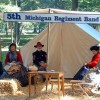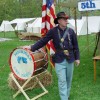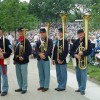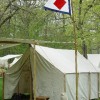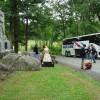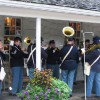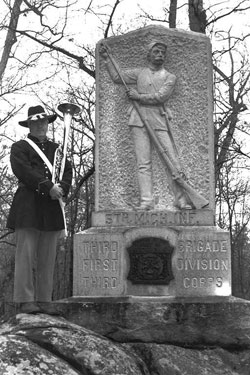 Esteemed member “Bradley Eide” contributes:
Esteemed member “Bradley Eide” contributes:
I recently attempted reading the letters of de Trobriand (the letters are in French) to his daughter contained in The Life and Memoirs of Comte Regis de Trobriand by Marie Post (his daughter). In a letter dated 4 July 1863 he states: He was…”principally with the 5th Michigan, a regiment of lions.”
From the Gettysburg Discussion Group
Much has been written regarding General Sickles decision to move his 3rd Corps off Cemetery Ridge during the 2nd day of the Battle at Gettysburg. The 5th Michigan had a significant part to play in this maneuver. In the American Encyclopedia is found the following notice of the 3d Corps:
General Sickles having sent out a regiment (5th infantry, while the 3rd Michigan was also on the same picket line) of sharpshooters about a mile beyond the Emmettsburg turnpike, they reported that the enemy were moving in large masses to turn the Union left. On this report General Sickles moved up to a ridge in front, which he deemed a more commanding position to repel the attack, and formed his line. He had hardly got into position when the enemy made their anticipated attack. After resisting it about two hours, and the 5th corps failing to come up to his support as promptly as was expected, he fell back to his original position upon the crest of the hill, where a most desperate assault was made by the troops of General Longstreet. The line was strengthened by General Meade, by ordering up the 5th corps and two divisions of the 12th to the position they afterwards occupied on the left of the 3rd. This formidable opposition and the predictable and rugged character of the slope effectually repulsed all efforts of General Longstreet, with great loss, however, on both sides.
Report of General De Trobriand, commanding brigade:
Headquarters 3d Brigade, 1st. Div. 3d Army Corps,
In the Field, July 27, 1863
Capt. Fitzhugh Birney, Asst. Adjutant General, 1st Division:
CAPTAIN, — I have the honor of submitting the following report of the part acted by the 3rd brigade, 1st division, 3d army corps, under my command at the battle of Gettysburg, on the 2d and 3d instant.
The battle was then raging on my left and right, to the rear, on both sides, in consequence of my advanced position, as already explained, and soon the two attacks came converging on the angle of which I formed the summit, with the 5th Michigan infantry, Lieutenant Colonel Pulford commanding. * * * Fortunately my position then was a strong one in a wood commanding a narrow ravine, which the enemy attempted in vain to cross under our fire. The unflinching bravery of the 5th Michigan, which sustained a loss of more than one-half of its numbers without yielding a foot of ground, deserves to be especially mentioned here with due commendation.
Respectfully submitted,
R. De Trobriand
Commanding Brigade.
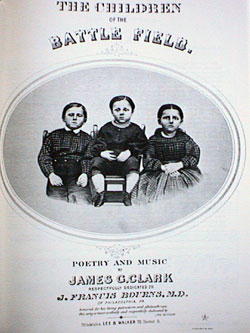 The Children of the Battle Field
The Children of the Battle Field
“Few readers of the public journals will fail to remember that, after the battle of Gettysburg, a dead soldier was found on the field, clasping in his hand an ambrotype of his three little children. No other incidient of the present fratricidal war is known to have so touched the heart of the nation. For months after the battle, the soldier’s name, and the home of his family, were a mystery. The ambrotype found within his clasped hands was obtained by J. Francis Bourns, M.D., of Philadelphia, who had the picture photographed, in the hope that its circulation might lead to the discovery of the family, and the soldier’s own recognition, and, at the same time, that the sales of the copies might result in a fund for the support and education of the little ones thus left fatherless. Publicity was also given to the incident in many newspapers throughout the country. From various quarters letters of affecting inquiry were soon received; but still the mystery of the soldier was unsolved. At length, in the month of November, a letter arrived with the intelligence that a soldier’s wife at a little town on the Allegheny River, in Western New York, had seen the account of the picture in a religious paper, the American Presbyterian, of Philadelphia, – a single copy of which was taken in the place. She had sent her husband such a picture, and had not heard from him since the sanguinary struggle at Gettysburg. With trembling anxiety she awaited the reply and the coming of the picture. A copy of it came, and was the identical likeness of her own children, and told the painful story that she was a widow and her little ones were orphans. The unknown soldier was thus ascertained to be Amos Humiston, late of Portville, Cattaraugus county, New York, sergeant in the 154th N.Y. Volunteers.
“…The fine lithograph on the title-page is an accurate copy of the original picture which was found in the hands of the dead hero, and a correct likeness of his children. The following simple, sweet verses originally appeared in the religious paper referred to above, having received the premium awarded for a poem on the subject by the publisher. The music, as well as the song, is from the same gifted author.”
Excerpts from, The Civil War Songbook
Background Music: The Children of the Battle Field
